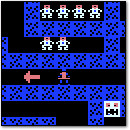[ Retro Scan of the Week ] The Canon AS-100
Monday, July 23rd, 2012 The good, the bad, and the obscure.
The good, the bad, and the obscure.
There’s a vast wilderness of little-known business micros that have long been overshadowed by the IBM PC and its brethren in the history books. Seen here is one such machine, the Canon AS-100, which sported an Intel 8088 CPU but was not an IBM PC clone (in other words, it could run MS-DOS, but was not hardware compatible with the PC).
Machines like this one tend to get overlooked historically because they were very expensive (this machine retailed for $3495 in 1983, or about $8,052 today) and they deviated from the emerging business standard of the IBM PC compatible. With those two elements combined, they sold relatively poorly — and, being business-oriented, they also never became notable gaming platforms (enthusiasm for retrogaming brings a lot of attention to certain classic PCs that otherwise might have been forgotten).
Speaking of gaming platforms, the color capabilities of this machine look amazing for 1983. I wonder if anyone ever did write a game for it that took advantage of those high-end graphical specs.
Discussion Topic of the Week: What’s the most obscure computer model you’ve ever used? Something that you think no one has ever heard of.














